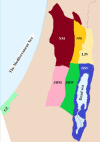Analysis of floristic composition and species diversity of vascular plants native to the State of Palestine (West Bank and Gaza Strip)
- PMID: 36761642
- PMCID: PMC9848539
- DOI: 10.3897/BDJ.10.e80427
Analysis of floristic composition and species diversity of vascular plants native to the State of Palestine (West Bank and Gaza Strip)
Abstract
This study aims at providing an updated checklist of the native vascular flora of the Palestinian West Bank and Gaza Strip (State of Palestine, SP), serving as a taxonomic and nomenclatural basis for botanical research and encouraging new floristic surveys and biosystematic studies. The study provides an up-to-date checklist of native vascular taxa of the SP and their distribution within the plant districts in the country. This is the very first annotated checklist for the native vascular plants of the SP which incorporates recent name changes, new distribution records, habitat, herbarium specimens catalouge, Red List criteria, wild edible plants, endemism and use in Traditional Palestinian Herbal Medicine. The quantitative analysis of the flora has shown that the SP hosts 1826 taxa, distributed in 686 genera and 108 families; five taxa are gymnosperms, nine taxa are Pteridophytes and 1812 taxa are angiosperms. The most represented families are Leguminosae (222 taxa, 12.2%), Asteraceae (197, 10.2%) and Poaceae (196, 10.7%), while the most represented genera are Trifolium (38, Leguminosae), Silene (32, Caryophyllaceae), Astragalus (27, Leguminosae), Medicago (26, Leguminosae), Allium (25, Amaryllidaceae) and Euphorbia (25, Euphorbiaceae). Annuals (52.4%), Hemicryptophytes (20.2%) and Chamaephytes (12.2%) are the most represented life-forms amongst the SP flora. The richest plant districts in the SP vascular plant taxa are Gaza Strip (GS) (1216 taxa), Jerusalem and Hebron Mountains (JHM) (1235) and Nablus Mountains (NM) (1126). Agglomerative hierarchical clustering (AHC) permitted the division of SP into two main regions, based on the existence of vascular plant taxa: Region 1 (western plant districts with 1128-1237 taxa) with higher water availability and temperate Mediterranean climate which permit the establishment of more than 65% of the total SP flora in these districts and Region 2 (eastern plant districts with 571-698 taxa), characterised by desert and semi-desert conditions, as well as the presence of alluvial and co-alluvial soils, which allow the survival of lower numbers of plant taxa. One hundred and sixty-five taxa of the SP flora are endemic and near-endemic. However, in comparison with some countries of the Mediterranean Basin, this number is below the average endemism concentration, along with other southern arid countries, such as Tunisia and Egypt. In total, there are 102 threatened plant taxa, belonging to 39 families and 83 genera representing 5.6% of the total plants in the SP. IUCN and the Conservation Measures Partnership (CMP) unified classification of direct threats for SP Red-Listed plants has shown a high extinction risk to the Palestinian threatened wild flora, with 76.5% of the threatened species being either critically endangered (CR) or endangered (EN); only 23.5% were vulnerable (VU). However, several taxa are threatened by numerous factors including small population size, human activities, for example, conversion of traditional to intensive agriculture accompanied by deep ploughing and the application of pesticides, urban development and construction, global climatic change, drying of marshes and wetlands, quarrying, fires and pollution. This checklist can help focus conservation efforts and provide a framework for research, protection and policy applications for the SP flora, especially for the endemic and threatened plants.
Keywords: diversity; endemism; threatened plants; vascular plants.
Mohammed Saleem Ali-Shtayeh, Rana Majed Jamous, Salam Yousef Abuzaitoun.
Figures













Similar articles
-
The endemic plants of Mozambique: diversity and conservation status.PhytoKeys. 2019 Dec 11;136:45-96. doi: 10.3897/phytokeys.136.39020. eCollection 2019. PhytoKeys. 2019. PMID: 31866738 Free PMC article.
-
The Endemic Vascular Flora of Sardinia: A Dynamic Checklist with an Overview of Biogeography and Conservation Status.Plants (Basel). 2022 Feb 23;11(5):601. doi: 10.3390/plants11050601. Plants (Basel). 2022. PMID: 35270071 Free PMC article.
-
Endemism patterns of the vascular flora of Lebanon: A dynamic checklist.PhytoKeys. 2025 Jul 28;260:153-184. doi: 10.3897/phytokeys.260.156938. eCollection 2025. PhytoKeys. 2025. PMID: 40765900 Free PMC article.
-
A family-level floristic inventory and analysis of medicinal plants used in Traditional African Medicine.J Ethnopharmacol. 2020 Mar 1;249:112351. doi: 10.1016/j.jep.2019.112351. Epub 2019 Oct 30. J Ethnopharmacol. 2020. PMID: 31676399 Review.
-
South America holds the greatest diversity of native daisies (Asteraceae) in the world: an updated catalogue supporting continental-scale conservation.Front Plant Sci. 2024 May 30;15:1393241. doi: 10.3389/fpls.2024.1393241. eCollection 2024. Front Plant Sci. 2024. PMID: 38872876 Free PMC article. Review.
Cited by
-
New perspectives, additions, and amendments to plant endemism in a North African flora.Bot Stud. 2024 Jul 16;65(1):21. doi: 10.1186/s40529-024-00428-w. Bot Stud. 2024. PMID: 39012376 Free PMC article.
-
Biological, phytochemical and molecular docking characteristics of Laurus nobilis L. fresh leaves essential oil from Palestine.BMC Complement Med Ther. 2024 Jun 8;24(1):223. doi: 10.1186/s12906-024-04528-9. BMC Complement Med Ther. 2024. PMID: 38851735 Free PMC article.
References
-
- Abdeaal MOHAMED, Fois MAURO, Fenu GIUSEPPE, Bacchetta GIANLUIGI. Critical checklist of the endemic vascular plants of Egypt. Phytotaxa. 2018;360(1) doi: 10.11646/phytotaxa.360.1.2. - DOI
-
- Al-Eisawi D. M. Field guide to wild flowers of Jordan and neighboring countries. Jordan Press Foundation; Amman, Jordan: 1998. 296
-
- Al-Eisawi D. M. Flora of Jordan checklist. 1. the University of Jordan press; Amman-Jordan: 2013. 18
-
- Al-Eisawi D. M., Oran S. A. Assessment of the vegetation cover of northern high mountains in Jordan. Journal of Biodiversity and Environmental Sciences (JBES) 2015;6:93–106.
-
- Ali-shtayeh M S., Jamous R M., Hamad A K. Guide to trees and shrubs from Palestine. Biodiversity and Environmental Research Center; Til, Nablus: 2003.
LinkOut - more resources
Full Text Sources
Research Materials
